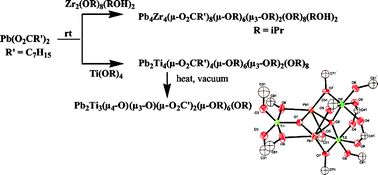Interplay between lead carboxylate and Ti or Zr isopropoxides in solution routes to perovskites: synthesis, molecular structures and reactivity of single source non-oxo Pb–Zr and Pb–Ti carboxylatoalkoxides supported by 2-ethylhexanoate ligands
Abstract
The reactions between Ti(OiPr)4 and Zr2(OiPr)8(HOiPr)2, respectively, and lead 2-ethylhexanoate Pb(O2CC7H15)2 have been investigated at rt and by heating. The initial mixed-metal species, characterized by single-crystal X-Ray diffraction, were adducts namely Pb4Zr4(µ-O2CR′)8(µ-OR)6(µ3-OR)2(OR)8(OHR)21 and Pb2Ti4(µ-O2CR′)4(µ-OR)6(µ3-OR)2(OR)82 (R′ = CHCH(Et)C2H4Me, R = iPr) independently of the stoichiometry used. They are the first Pb–Ti and Pb–Zr non-oxo carboxylatoalkoxides reported. 1 is also the first Pb–Zr species based on an alkoxide-carboxylate ligand set matching the PbZrO3 stoichiometry. Both structures are centrosymmetric with six-coordinate transition metals, as required for the perovskite, and are based on triangular M2Pb cores (M = Zr, Ti). The lead centers display quite high coordination numbers, six and seven. The thermal and hydrolytic condensation reactions of 1 and 2 were investigated. Heat treatment of 2 and elimination of the volatiles under vacuum afforded Pb2Ti3(µ4-O)(µ3-O)(µ-O2CC7H15)2(µ-OiPr)6(OiPr)43 resulting from extrusion of Ti(OiPr)4 and scrambling of carboxylate ligands. Characterization of the various compounds was achieved by elemental analysis, FT-IR, 1H and 207Pb NMR.


 Please wait while we load your content...
Please wait while we load your content...